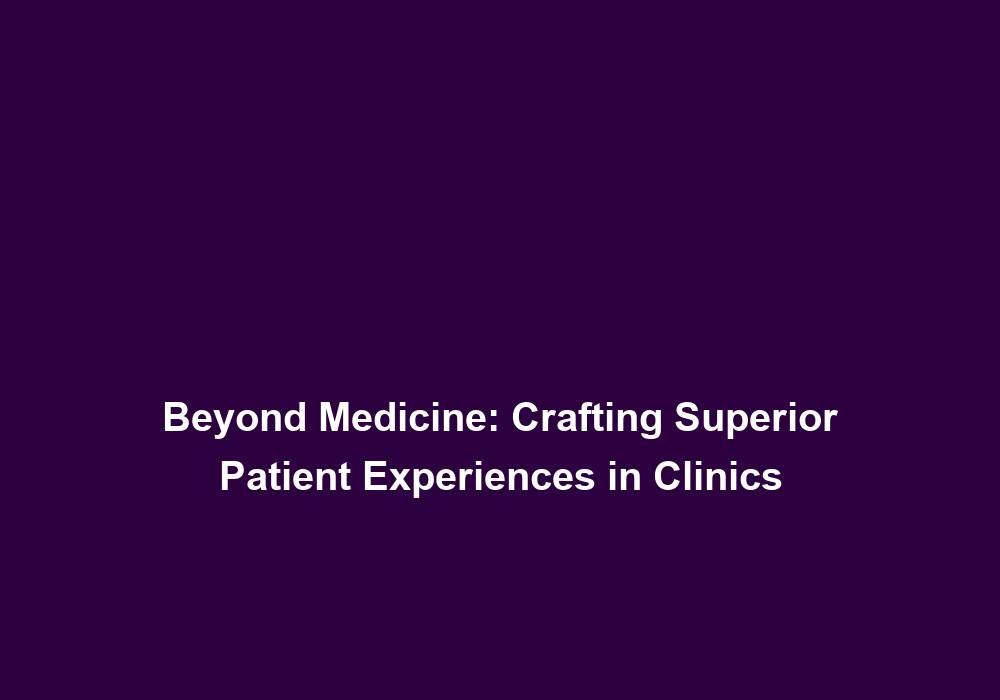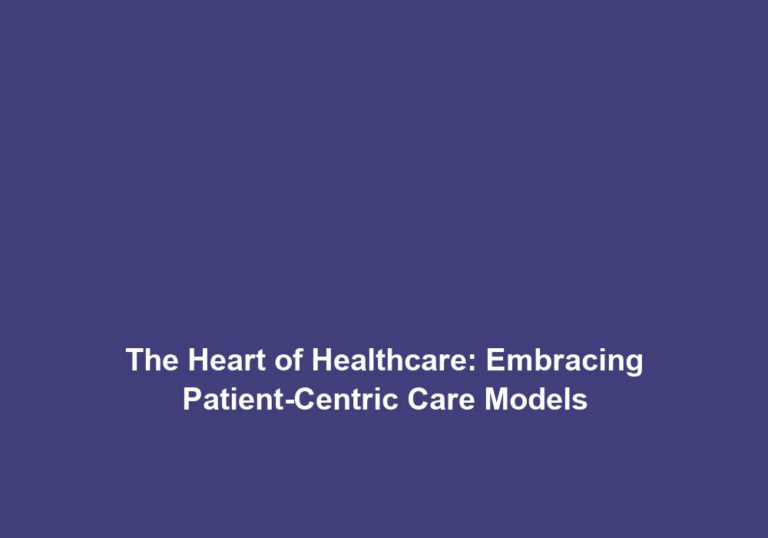Beyond Medicine: Crafting Superior Patient Experiences in Clinics
In today’s healthcare landscape, the focus on patient experiences has become increasingly important. Healthcare providers are realizing that it’s not just about providing medical treatments and interventions but also creating an environment that fosters trust, comfort, and satisfaction for patients. This article explores the concept of crafting superior patient experiences in clinics, going beyond the scope of medicine itself.
The Importance of Patient Experiences
Patients expect more than just a diagnosis and treatment plan when they visit a clinic. They seek empathy, care, and personalized attention. A positive patient experience can significantly impact patient satisfaction, loyalty, and even health outcomes. It is essential for clinics to understand that the patient experience starts from the moment a patient enters the clinic and goes beyond the actual medical encounter.
Establishing a Welcoming Environment
-
Comfortable Waiting Areas: The waiting area is often the first point of contact for patients. It should be designed to provide comfort and relaxation, with comfortable seating, ample lighting, and a calming ambiance. Consider incorporating natural elements, such as plants, to create a soothing atmosphere. This can help alleviate anxiety and promote a positive mindset for patients.
-
Efficient Check-In Process: Streamlining the check-in process is crucial for reducing patient stress and wait times. Implementing self-check-in kiosks or online check-in options can save time and enhance the overall patient experience. By providing these convenient options, clinics can minimize the time patients spend waiting and create a more efficient and patient-centered environment.
-
Friendly Staff: The front desk staff, nurses, and medical assistants play a vital role in creating a positive patient experience. Train your staff to greet patients warmly, address their concerns, and provide clear communication throughout their visit. Encourage a culture of empathy and compassion, where staff members actively listen to patients and go the extra mile to ensure their comfort and satisfaction.
Enhancing Communication
-
Active Listening: Healthcare providers must actively listen to their patients, ensuring that their concerns and preferences are acknowledged and addressed. This simple act can significantly improve patient satisfaction and trust in the healthcare provider. By actively engaging with patients, healthcare providers can build strong patient-provider relationships based on mutual respect and understanding.
-
Clear and Transparent Communication: Using plain language and avoiding medical jargon when explaining diagnoses, treatment options, and procedures can help patients better understand their condition and actively participate in their healthcare decisions. Breaking down complex medical information into simple terms enables patients to make informed choices and actively engage in their own care.
-
Timely and Respectful Communication: Promptly responding to patient inquiries and providing updates on test results or appointments is a crucial aspect of patient-centered care. Respectful communication, both in-person and through various communication channels, fosters trust and confidence in the clinic. By offering clear and timely communication, clinics can ensure that patients feel valued and well-informed throughout their healthcare journey.
Personalizing the Patient Experience
-
Individualized Care Plans: Rather than adopting a one-size-fits-all approach, clinics should strive to develop personalized care plans for each patient. This involves taking into account their unique needs, preferences, and goals to provide a tailored treatment experience. By considering the individual circumstances of each patient, clinics can provide more effective and patient-centric care.
-
Collaborative Decision-Making: Encouraging shared decision-making between healthcare providers and patients can empower patients to actively participate in their care journey. It provides them with a sense of control and allows for a more personalized treatment experience. By involving patients in the decision-making process, clinics can ensure that treatments align with patient preferences and values, leading to improved patient satisfaction.
-
Holistic Care Approach: Beyond medical interventions, clinics can offer complementary services such as nutritional counseling, mental health support, or physical therapy. This holistic approach considers the overall well-being of patients, contributing to a superior patient experience. By addressing not only the physical health but also the mental, emotional, and social aspects of patients’ lives, clinics can provide comprehensive care that goes beyond the traditional boundaries of medicine.
Embracing Technology
-
Online Appointment Scheduling: Offering online appointment scheduling options can enhance convenience and reduce wait times for patients. It allows them to choose a suitable time slot and receive reminders, ultimately improving their overall experience. By leveraging technology, clinics can streamline the appointment process and provide patients with greater control and flexibility in managing their healthcare appointments.
-
Electronic Medical Records (EMRs): Implementing EMRs can streamline administrative tasks, reduce paperwork, and improve patient safety and continuity of care. Having access to accurate and up-to-date medical records allows for more efficient and personalized healthcare delivery. EMRs enable healthcare providers to access patient information quickly, make informed decisions, and provide seamless care across different healthcare settings.
-
Telemedicine Services: The recent advancements in telemedicine have revolutionized patient care. Offering virtual consultations and follow-ups not only improves access to care but also eliminates geographical barriers, making healthcare more convenient for patients. Telemedicine allows patients to receive medical advice and treatment remotely, reducing the need for in-person visits and enhancing the overall patient experience.
Continuous Improvement and Feedback
-
Patient Surveys: Implementing patient satisfaction surveys can provide valuable insights into areas for improvement. Regularly collecting feedback allows clinics to identify strengths and weaknesses in their patient experience strategies and make necessary adjustments. By actively seeking feedback from patients, clinics can continuously improve their services and ensure that patient needs and expectations are met.
-
Staff Training and Development: Investing in staff training and development programs can equip healthcare providers with the necessary skills to deliver exceptional patient experiences. This includes training in communication, empathy, cultural competency, and customer service. By providing ongoing training opportunities, clinics can empower their staff to consistently deliver high-quality care and create positive patient experiences.
-
Quality Improvement Initiatives: Continuously evaluating and improving clinic processes, such as reducing wait times, enhancing appointment scheduling systems, or implementing patient-centered policies, demonstrates a commitment to providing superior patient experiences. By regularly reviewing and refining operational processes, clinics can optimize efficiency, enhance patient satisfaction, and ensure the delivery of high-quality care.
By focusing on these strategies, clinics can go beyond the traditional boundaries of medicine and create an environment that prioritizes the holistic well-being of patients. Crafting superior patient experiences not only promotes patient satisfaction and loyalty but also contributes to better health outcomes and a positive reputation for the clinic.







